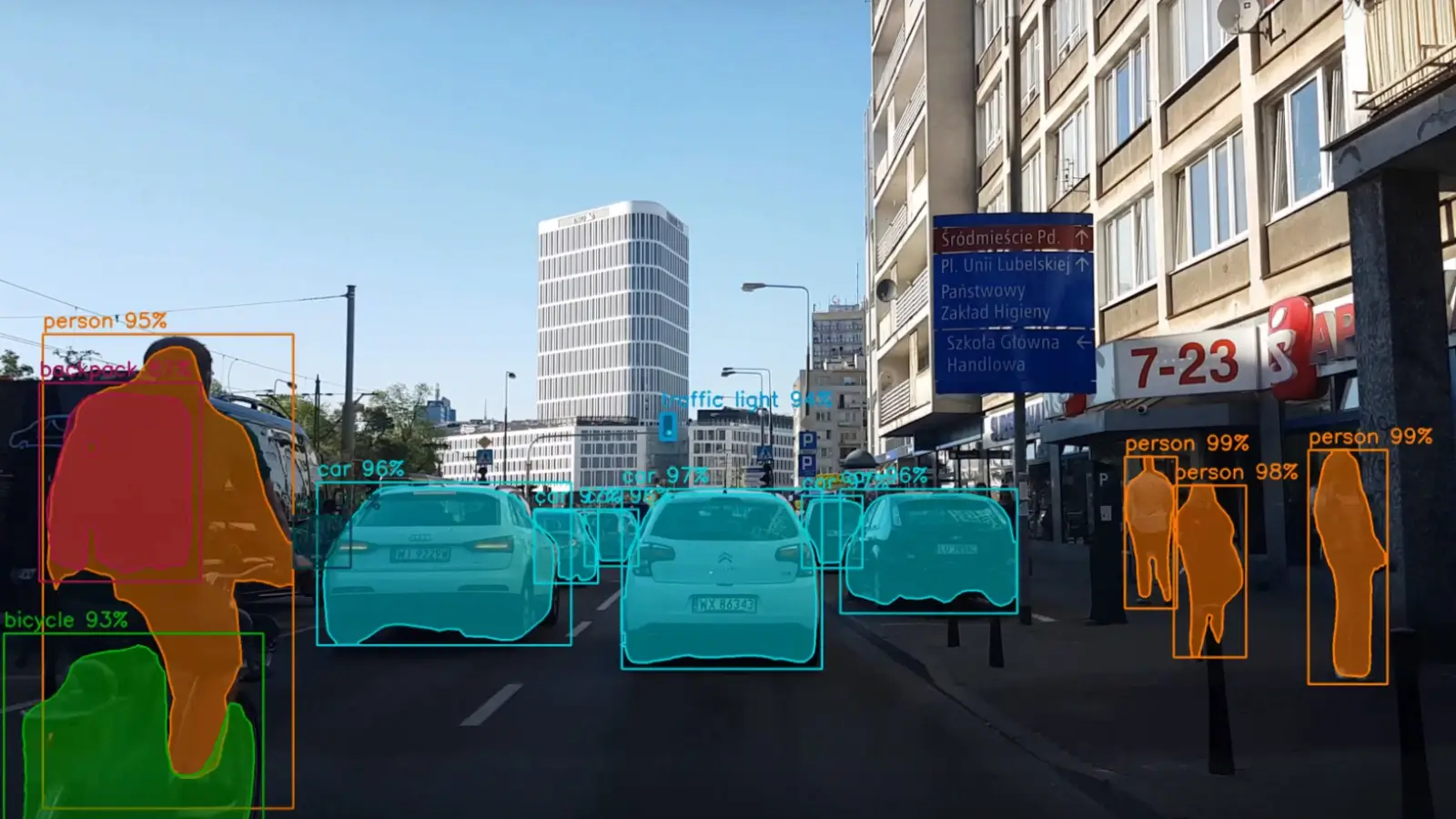— Semantic segmentation enables AI to interpret visual data at pixel-level precision, revolutionizing industries like healthcare, robotics, and autonomous vehicles.
With the advancements in artificial intelligence (AI) and computer vision, autonomous vehicles and robotics are rapidly extending into fields such as healthcare, retail, and agriculture. At the core of these innovations is the ability of machines to interpret and understand visual data with remarkable accuracy. Semantic segmentation plays a crucial role in this process by offering a detailed, pixel-by-pixel classification of images, enabling AI systems to distinguish between different objects and their surroundings.
This article explores how semantic segmentation enhances object detection and image comprehension, highlights state-of-the-art techniques, and identifies leading companies providing these services.
Understanding Semantic Segmentation
Semantic segmentation is a computer vision technique that involves assigning a specific class label to each pixel in an image. Unlike object detection, which identifies objects within bounding boxes, semantic segmentation delivers a complete and fine-grained understanding of the scene.
For example, in a street view image, semantic segmentation would label each pixel as a car, pedestrian, road, tree, or building. This level of granularity helps AI systems not only recognize objects but also understand their shapes, sizes, and spatial relationships.
Applications of Semantic Segmentation
Semantic segmentation is utilized across diverse industries and applications, including:
- Autonomous Driving: Recognizing lanes, pedestrians, and vehicles for safer navigation.
- Medical Imaging: Identifying organs, tissues, and tumors for accurate diagnosis.
- Agriculture: Differentiating between crops, soil, and weeds for precision farming.
- Retail and E-commerce: Enabling product recognition and visual inventory management.
Enhancing Object Detection with Semantic Segmentation
Semantic segmentation complements object detection by providing pixel-level precision, which increases overall accuracy and reduces false positives. Key advantages include:
- Improved Precision: Pixel-level labeling helps differentiate overlapping or partially obscured objects.
- Contextual Understanding: Enables AI to understand the environment surrounding objects for better decision-making.
- Higher Edge Accuracy: Improves boundary identification in dense or complex scenes.
- Enhanced Scene Parsing: Allows systems to interpret entire scenes, crucial for robotics and autonomous navigation.
By integrating both object detection and semantic segmentation, AI systems achieve superior localization and scene comprehension, leading to more reliable performance.
State-of-the-Art Semantic Segmentation Techniques
Modern AI systems employ advanced deep learning models to improve segmentation performance, such as:
- Fully Convolutional Networks (FCNs): Replace fully connected layers with convolutional layers for pixel-level predictions.
- U-Net Architecture: Designed for medical imaging, it captures contextual information across multiple scales.
- DeepLab Models: Utilize atrous convolution and spatial pyramid pooling for multi-scale feature extraction.
- Mask R-CNN: Extends object detection models by adding segmentation masks.
- 3D Semantic Segmentation: Applies to LiDAR and point cloud data for robotics and autonomous vehicles.
These innovations enable AI models to process complex, real-world environments with greater accuracy and reliability.
Advantages of Outsourcing Semantic Segmentation Services
Partnering with professional semantic segmentation service providers offers significant benefits:
- Scalability: Efficiently process large datasets of images, videos, and 3D data.
- Consistency: Ensures standardized, high-quality labeled data.
- Cost and Time Efficiency: Eliminates the need for internal annotation teams.
- Customization: Tailored annotation based on industry and use case.
- Higher Model Accuracy: Enhances model precision, robustness, and generalization.
Professional semantic segmentation services are essential for developing high-performing, dependable computer vision systems.
Industry Applications Empowered by Semantic Segmentation
- Autonomous Vehicles: Recognize road elements, pedestrians, and obstacles to ensure safe navigation.
- Healthcare: Identify tumors, lesions, and organ boundaries for faster and more accurate diagnosis.
- Robotics: Enable autonomous navigation and interaction with dynamic environments.
- Agriculture: Enhance crop monitoring, soil analysis, and yield optimization.
- Retail and E-commerce: Support visual product search, shelf management, and automated inventory tracking.
For deeper insights, refer to Semantic Segmentation: Key Challenges, Techniques, and Real-World Applications.
Key Competitors in the Semantic Segmentation Service Industry
Several leading companies deliver high-quality annotated datasets for semantic segmentation and computer vision projects:
- Digital Divide Data (DDD): Provides comprehensive, high-precision semantic segmentation solutions for computer vision and autonomous technologies.
- Scale AI: Provides large-scale semantic segmentation and computer vision services for autonomous systems.
- Appen: Specializes in data annotation and labeling for various AI applications.
- Lionbridge AI: Offers segmentation services for healthcare, automotive, and retail industries.
- Playment: Delivers efficient and accurate image and video segmentation for AI model training.
Digital Divide Data (DDD) – Semantic Segmentation Services
Digital Divide Data (DDD) is a global leader in delivering end-to-end semantic segmentation and AI data annotation solutions. DDD empowers organizations with reliable and scalable datasets designed for autonomy, vision, and intelligent systems.
Key Offerings:
- Comprehensive Pixel-Level Annotation: Accurate labeling of images and videos for AI model training.
- 3D & LiDAR Segmentation: Specialized support for robotics, drones, and autonomous vehicles.
- AI-Assisted Annotation Tools: Combines human expertise with AI-driven precision for efficiency and consistency.
- Cross-Industry Solutions: Supports healthcare, automotive, agriculture, and retail computer vision applications.
- Quality Assurance & Compliance: Adheres to strict quality control and ethical data-handling standards.
DDD’s semantic segmentation services enable companies to accelerate model development while maintaining high accuracy, scalability, and ethical data practices, helping shape the future of AI-powered vision systems.
Future Trends in Semantic Segmentation
Semantic segmentation continues to evolve, driven by the demand for intelligent, real-time AI applications. Key trends include:
- Integration with Generative AI: Synthetic data generation for model training.
- Expansion into 3D Segmentation: Applied to LiDAR and 3D mapping for autonomous mobility.
- Real-Time Segmentation: Increasingly used in vehicles, drones, and augmented reality.
- AI-Based Annotation Systems: Automate labeling while maintaining high precision.
Conclusion
Semantic segmentation is a transformative technology that enhances object detection and image understanding, enabling AI systems to interpret complex scenes with precision. For industries seeking scalable and accurate computer vision solutions, professional segmentation services, such as those provided by Digital Divide Data (DDD), are critical.
As AI adoption grows, semantic segmentation will remain a cornerstone in building smarter, safer, and more adaptive intelligent systems.


